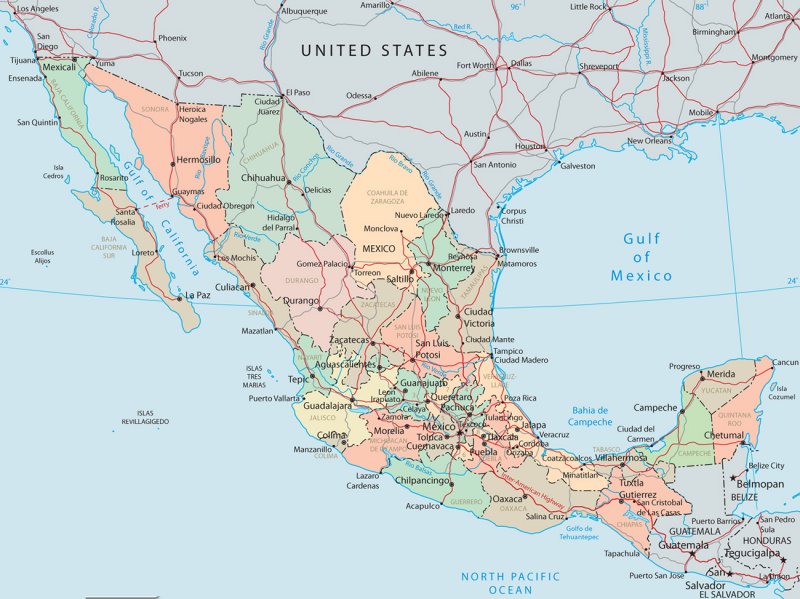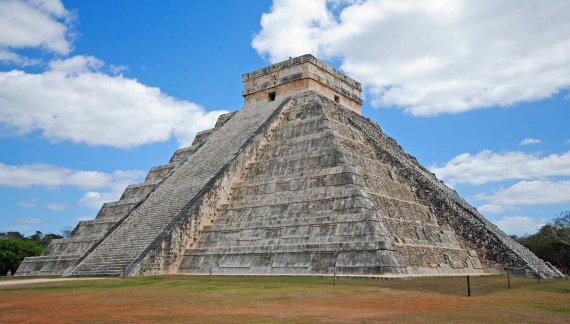
As the map shows, Mexico is both the southernmost country in North America and the northernmnost in Central America. Its historic cultural ties go in both directions, though subsequent divisions between English-speaking and Spanish-speaking Americas have made that less obvious. Texas, and part of California, were once part of Mexico - see our USA page. Map courtesy of Geographic Guide
The Olmecs
The earliest known civilization in Mexico was the Olmec culture, which flourished between 1200 and 400 BC. Little is known about them but they left the most amazing artworks, some naturalistic, some stylized, and some on an extremely large scale. They lived along the Gulf of California, in the present day states of Vera Cruz and Tabasco. The name Olmec (meaning rubber people) is a later atrribution, based on the fact that they developed the technology of rubber manufacture. They probably practised circumcision, but we have no firm evidence.
The Aztecs
 After the demise of the Olmec civilisation Mexico was divided into multiple city states, sometimes at war with each other, sometimes at peace. In 1427 three city-states, Tenochtitlan, Texcoco and Tlacopan, joined forces to overthrow the previously dominant Tepanec and established the Aztec empire. By the time the Spaniards under Hernán Cortés arrived in 1521 unrest was already brewing, and Cortés took advantage of this to seize control.
After the demise of the Olmec civilisation Mexico was divided into multiple city states, sometimes at war with each other, sometimes at peace. In 1427 three city-states, Tenochtitlan, Texcoco and Tlacopan, joined forces to overthrow the previously dominant Tepanec and established the Aztec empire. By the time the Spaniards under Hernán Cortés arrived in 1521 unrest was already brewing, and Cortés took advantage of this to seize control.
An Aztec pyramid, courtesy of Historyplex
At their peak the Aztecs ruled 11 million people. They had a huge appetite for human sacrifices - probably no other civilization has come near them in this regard. They practiced circumcision (1), which of course the Spaniards didn't like, but were sexually conservative. Both adultery and homosexuality carried the death penalty. Not that that mattered to the Spaniards - their previous encounters with the Maya (see our Central America page) had convinced them that all Native Americans were sodomites, and they weren't going to let mere facts get in the way (2). The conqistadores wanted to use this factoid to regard the natives as brutes, and enslave or exterminate them. The Pope wasn't having that, and insisted that they by treated as humans and converted to Christianity. Anyway, circumcision had to go.
Present-day Mexico
Reports from readers are that circumcision is regarded as a status symbol and is common amoung the middle and upper classes, particularly in Mexico City. An academic source confirms this: "Circumcision is not usually performed by public sector health care providers in Mexico and we estimate the prevalence to be 10% to 31%, depending on the population." (3). This seems to give Mexico the highest circumcision rate in Latin America.
Acknowledgements
We acknowledge information from Wikipedia, Britannica and Ancient History Encyclopedia.
Thanks to Circlist readers for their comments - more are very welcome.
References1. W.D. Dunsmuir & E.M. Gordon, The history of circumcision. BJU International 83, Suppl.1, 1-12 (1999)
2. Reay Tannahill, Sex in History. Hamish Hamilton, London, 1980, 480pp
3. Martín Lajous, Eduardo Lazcano-Ponce and Nancy Mueller, replying to Robert S. Van Howe and Christopher J. Cold Letter to the Editor. Cancer Epidemiology, Biomarkers & Prevention Volume 15, Issue 2, pp. 405-406 (2006). Read it online here.
Copyright © 1992 - 2018, All Rights Reserved CIRCLIST.

